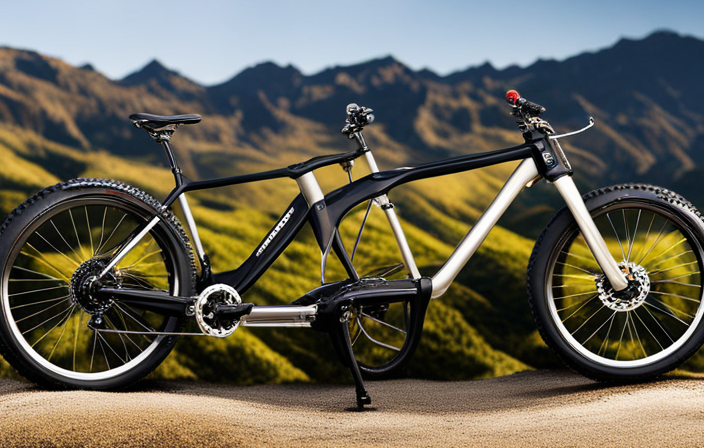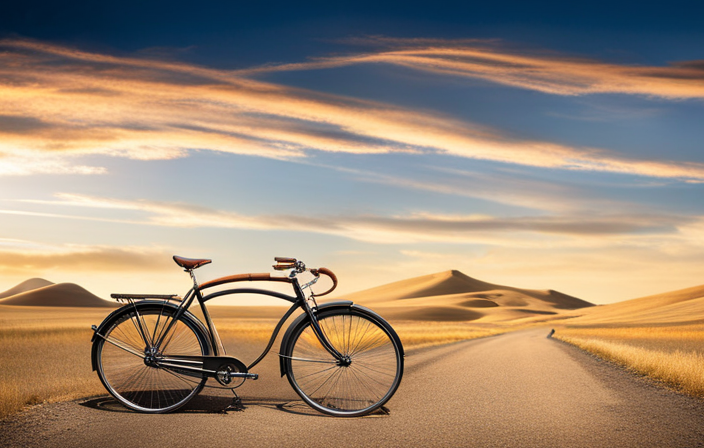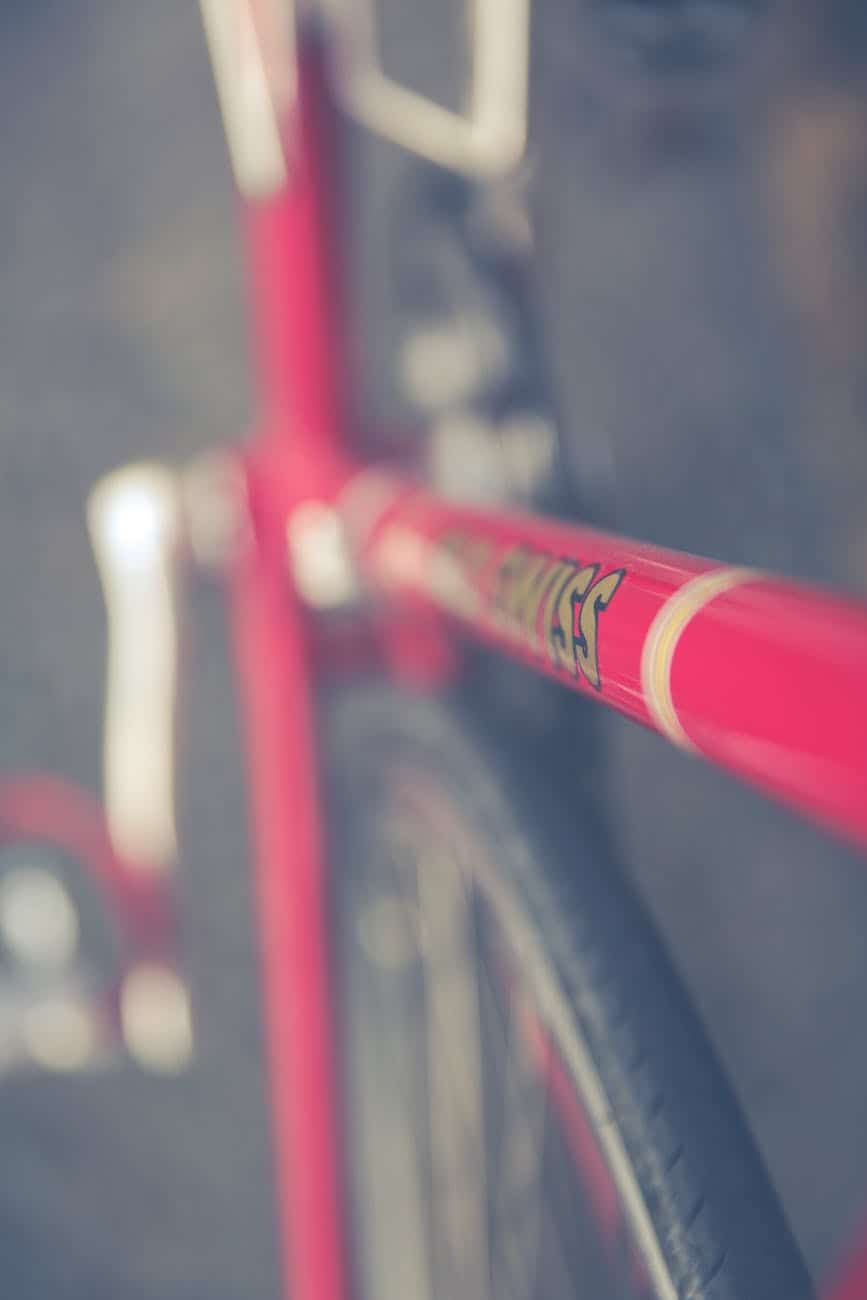If you’re someone who enjoys venturing off the main roads on a bicycle, you understand how crucial it is to have a suitable bike for rough and gravelly terrain. The multitude of choices available can make it difficult to decide. That’s why I’ve conducted thorough research to help you make an informed choice.
In this article, we’ll dive into the different types of bikes that excel on rough terrain. From gravel bikes to hardtail mountain bikes, we’ll explore all your options so you can make an informed decision and enjoy every adventure ahead.
Key Takeaways
- Gravel bikes, cyclocross bikes, adventure bikes, hardtail mountain bikes, and fat bikes are suitable for gravel and bumpy roads.
- These bikes offer features such as sturdy frames, wide tires, ample storage options, suspension forks, electric power, and low maintenance.
- Custom-built frames for gravel riding provide optimal performance, comfort, personalized paint jobs, and enhanced stability and control.
- Tire selection is important, and opting for wider tires with grip and durability, as well as using tubeless tires, can enhance puncture resistance, lower rolling resistance, and provide optimal performance.
Gravel Bikes
You’ll need a gravel bike for those gravel and bumpy roads. Gravel bikes are specifically designed to handle rough terrain, making them the perfect choice for riders who want to venture off-road. These bikes have certain features that set them apart from other types of bicycles.
One key feature of a gravel bike is its wider tires. Unlike road bikes, which usually have narrow tires, gravel bikes come with wider tires that provide better traction and stability on uneven surfaces. This allows you to navigate through loose gravel and bumps with ease.
Another important feature is the frame geometry of a gravel bike. These bikes typically have a more relaxed geometry compared to road or cyclocross bikes. The slightly longer wheelbase and lower bottom bracket give you more stability while riding over rough terrain.
When considering whether to choose a gravel bike or a cyclocross bike, it’s important to note that while they may look similar, there are some key differences. Cyclocross bikes are built for racing on mixed terrains and tend to have a more aggressive geometry. They also usually have higher bottom brackets and narrower tire clearance compared to gravel bikes.
In conclusion, if you’re planning on riding on gravel and bumpy roads, a gravel bike is your best bet. With their wide tires and relaxed geometry, these bikes provide the comfort and stability needed for off-road adventures. Now let’s dive into the world of cyclocross bikes…
Cyclocross Bikes
Cyclocross bikes are suitable for rough terrain and uneven surfaces. They are designed specifically for off-road riding, making them a great choice for gravel and bumpy roads. Here are four key features that make cyclocross bikes perfect for these conditions:
-
Tough Frames: Cyclocross bikes have sturdy frames made from materials like aluminum or carbon fiber, ensuring durability and resistance to impacts.
-
Wide Tire Clearance: These bikes typically come with wider tire clearance, allowing you to fit larger tires with more traction. This helps absorb shocks and provides better stability on rough surfaces.
-
Disc Brakes: Most cyclocross bikes come equipped with disc brakes, offering superior stopping power in wet or muddy conditions. This is especially important when navigating unpredictable terrains.
-
Aggressive Geometry: Cyclocross bikes have a more aggressive geometry compared to other road or touring bikes, providing a responsive and nimble ride on challenging terrains.
Using a cyclocross bike brings several benefits when riding on gravel and bumpy roads. The robust construction ensures the bike can handle the challenges of uneven surfaces while providing stability and control. The wider tires offer increased traction and comfort, reducing the risk of slipping or getting stuck in loose terrain.
Now let’s transition into discussing adventure bikes without missing a beat…
Adventure Bikes
Adventure bikes are the perfect choice for those seeking long-distance rides and exploration. With their sturdy frames and ample storage options, these bikes can handle any terrain you throw at them.
Whether you’re embarking on a multi-day bikepacking trip or simply tackling bumpy gravel roads, adventure bikes are designed to keep you comfortable and prepared for whatever comes your way.
Built for long-distance rides and exploration
If you’re looking for a bike that’s perfect for long-distance rides and exploring, a gravel or adventure bike would be an excellent choice. These bikes are built for endurance rides and can handle all weather conditions, making them suitable for any kind of adventure.
Equipped with fenders and racks, they are ideal for long distance touring, allowing you to carry all your essentials with ease. Additionally, these bikes are designed specifically for gravel racing and bikepacking, ensuring a smooth ride even on bumpy terrain.
With sturdy frames and ample storage options, you can bring everything you need on your journey without feeling weighed down.
Transitioning into the next section about the bikes being equipped with sturdy frames and ample storage options allows riders to tackle any challenge that comes their way.
Equipped with sturdy frames and ample storage options
With their durable frames and plenty of storage, these bikes are perfect for taking on any challenge. The sturdy frame benefits of these bikes cannot be overstated. They are specifically designed to withstand the rigors of gravel and bumpy roads, ensuring a smooth and comfortable ride even in the most rugged terrains.
The frames are made from high-quality materials that provide excellent stability and durability, allowing you to tackle any obstacle with confidence. Additionally, these bikes come equipped with ample storage options, making them ideal for long-distance rides and exploration. Whether you need to carry camping gear, extra clothes, or snacks for your adventure, these bikes have you covered.
Having enough storage space is crucial when embarking on such journeys as it allows you to stay self-sufficient throughout your ride without compromising on comfort or safety.
Transitioning into the subsequent section about hardtail mountain bikes…
Hardtail Mountain Bikes
To tackle gravel and bumpy roads, you’ll need a hardtail mountain bike. Hardtail mountain bikes are designed to handle rough terrains with ease, making them a perfect choice for adventurous riders seeking thrill on unpredictable surfaces. These bikes are equipped with sturdy frames, often made from materials such as aluminum or carbon fiber, which offer durability and strength while keeping the weight down.
One of the great things about hardtail mountain bikes is that they come in a variety of customizable options. From different frame sizes to custom paint jobs, you can personalize your ride to suit your style and preferences. This not only adds a touch of individuality but also allows you to choose a bike that fits you perfectly.
Additionally, hardtail mountain bikes often feature ample storage options. You can attach racks or bags to carry essentials like water bottles, tools, or even camping gear for those longer adventures. Having everything within easy reach ensures that you’re prepared for any situation that may arise during your off-road escapades.
As we transition into the subsequent section about fat bikes, it’s worth noting that while hardtail mountain bikes excel on gravel and bumpy roads, fat bikes take it a step further by offering even more stability and traction on challenging terrains.
Fat Bikes
Fat bikes are the ultimate off-road machines, designed for extreme terrain and conditions. With their wide tires, these bikes provide excellent grip and flotation on gravel, sand, snow, and bumpy roads.
Whether you’re tackling rocky trails or exploring remote areas, fat bikes offer superior stability and control to conquer any off-road adventure.
Perfect for extreme off-road conditions
Ideal for the roughest terrain, a bike built for extreme off-road conditions is a necessity. These bikes are perfect for tackling the most challenging trails and are designed to handle the harshest environments.
With their sturdy frames and wide tires, they provide excellent grip and flotation, allowing you to confidently navigate through gravel and bumpy roads. The rugged construction of these bikes ensures durability and stability, making them suitable for technical trails that require precision handling. Whether it’s loose rocks or uneven surfaces, these bikes can handle it all.
Additionally, they often come equipped with advanced suspension systems that absorb shocks and provide a smooth ride even on the toughest terrain. With their exceptional performance capabilities, these bikes are ready to take on any adventure off the beaten path.
Wide tires provide excellent grip and flotation
With their sturdy frames and wide tires, these bikes offer superior traction and buoyancy. The wide tires provide excellent grip and stability on gravel and bumpy roads, allowing you to confidently navigate through challenging terrains. Not only do they give you a smooth ride, but they also provide added stability when riding over loose surfaces. Additionally, these bikes often come equipped with tubeless tires, which offer puncture resistance. This means you can ride without worrying about getting a flat tire from sharp rocks or thorns commonly found on off-road trails.
Overall, these bikes are designed to handle extreme off-road conditions with ease, making them the perfect choice for adventurous riders seeking thrills in the great outdoors.
Transitioning into the next section about hybrid bikes:
Now that we’ve explored the benefits of gravel-specific bikes, let’s dive into another popular option – hybrid bikes.
Hybrid Bikes
If you’re looking for a bike that can handle gravel and bumpy roads, you’ll want to consider hybrid bikes. Hybrid bikes are designed to provide a versatile riding experience, combining features from both road and mountain bikes.
One of the main benefits of hybrid bikes is their ability to handle different types of terrain, making them perfect for gravel and bumpy roads. They typically come with wider tires compared to road bikes, providing better grip and stability on uneven surfaces.
Another advantage of hybrid bikes is their comfortable upright riding position. This allows for better visibility and reduces strain on your back during long rides on rough roads. Additionally, many hybrid bikes come with suspension forks or seat posts, which help absorb shocks and vibrations from uneven terrain.
However, it’s important to note that there are some drawbacks to consider when choosing a hybrid bike. Due to their versatility, they may not excel in specific areas such as speed or off-road trails compared to specialized road or mountain bikes. Additionally, the wider tires on hybrid bikes can increase rolling resistance on smooth surfaces.
Transitioning into the subsequent section about touring bikes, if you’re planning longer rides on gravel and bumpy roads while carrying additional gear, you might want to explore touring bikes for their added durability and load-carrying capacity without compromising comfort or performance.
Touring Bikes
When considering your options for a long-distance ride on various terrains, touring bikes offer the durability and load-carrying capacity you’re looking for. These bikes are specifically designed to handle gravel and bumpy roads, making them ideal for adventurous riders. One of the key features of touring bikes is their ability to carry heavy loads, which is essential when embarking on long trips. To enhance their functionality, there are several touring bike accessories available such as rear racks, panniers, and handlebar bags that provide ample storage space for your gear and supplies.
When it comes to choosing a touring bike brand, there are several reputable options available in the market. Some recommended brands include Surly, Trek, Salsa Cycles, and Kona. These brands have a proven track record of producing high-quality touring bikes that can withstand rough terrains while providing a comfortable ride.
Transitioning into the next section about electric bikes (e-bikes), these innovative bicycles have gained popularity among riders seeking an extra boost on challenging terrains without compromising on comfort or durability.
Electric Bikes (e-bikes)
Now that we’ve covered touring bikes, let’s dive into another exciting option for riding on gravel and bumpy roads: electric bikes, also known as e-bikes. E-bikes have gained popularity in recent years due to their versatility and ability to tackle various terrains with ease.
When it comes to riding on gravel, an electric mountain bike is a fantastic choice. Here are some benefits of using e-bikes for gravel riding:
-
Enhanced Power: With the assistance of a powerful electric motor, you can effortlessly conquer steep climbs and challenging terrain.
-
Extended Range: E-bikes typically come with larger batteries, allowing you to cover more distance on your gravel adventures.
-
Improved Stability: The added weight from the battery and motor provides increased stability, making it easier to navigate rough surfaces.
-
Reduced Fatigue: The electric assist feature helps minimize fatigue during long rides, ensuring you enjoy your time exploring gravel paths.
Transitioning into our next section about mountain bikes with suspension…
Mountain Bikes with Suspension
One popular option for riding on rough terrain is a mountain bike with suspension. Mountain bikes are specifically designed to handle off-road conditions, including gravel and bumpy roads. These bikes have sturdy frames and wider tires that provide better traction and stability. The most important feature of a mountain bike for this type of terrain is its suspension forks.
Suspension forks are located on the front wheel and absorb the impact from bumps and uneven surfaces, allowing for a smoother ride. They help to minimize the vibrations and shocks that can be felt through the handlebars, making it more comfortable to navigate gravel and bumpy roads. The suspension system also helps to improve control and handling, as it allows the wheels to maintain contact with the ground even when encountering obstacles.
Transitioning into the subsequent section about single-speed bikes: Speaking of different types of bikes, another option worth considering is a single-speed bike…
Single-Speed Bikes
If you’re looking for a low-maintenance option, consider getting yourself a single-speed bike. These bikes have only one gear, which means they don’t require the complex mechanisms and maintenance that come with geared bikes.
Here are some advantages and disadvantages of single-speed bikes:
-
Simplicity: With fewer parts to worry about, single-speed bikes are easier to maintain and repair.
-
Durability: Single-speed bikes are known for their durability since there are no delicate gears or derailleurs to break.
-
Affordability: Compared to geared bikes, single-speed options tend to be more affordable, making them a great choice for budget-conscious riders.
-
Fitness benefits: Riding a single-speed bike can provide a more challenging workout as you have to rely on your own strength and cadence without the help of multiple gears.
-
Fun factor: Many riders find the simplicity and purity of riding a single-speed bike enjoyable and liberating.
Now let’s transition into discussing gravel-specific frames without skipping a beat.
Gravel-specific Frames
When it comes to riding on gravel and bumpy roads, having a custom-built frame designed specifically for this type of terrain can make all the difference.
These frames are expertly crafted to offer optimal performance and comfort on rough surfaces, ensuring a smooth and enjoyable ride.
Whether you’re tackling challenging gravel paths or exploring off-road trails, investing in a gravel-specific frame will undoubtedly enhance your overall riding experience.
Custom-built frames designed for gravel riding
To navigate gravel and bumpy roads, you’ll need a bike with a custom-built frame specifically designed for gravel riding. These frames are tailored to handle the unique challenges of off-road terrain while offering optimal performance and comfort. Here are four key features to look for in custom-built frames:
-
Custom paint jobs: These frames often come with personalized paint jobs, allowing you to showcase your individual style and personality on the trails.
-
Frame materials: Custom-built frames can be made from various materials such as steel, titanium, or carbon fiber. Each material has its own characteristics that affect the bike’s weight, durability, and ride quality.
-
Enhanced stability: Gravel-specific frames typically have longer wheelbases and slacker geometry, providing better stability and control when tackling rough terrain.
-
Increased tire clearance: These frames offer ample tire clearance so you can equip wider tires for improved traction and a smoother ride.
Investing in a custom-built frame ensures that your bike offers optimal performance and comfort on rough terrain without compromising on style or functionality.
Offers optimal performance and comfort on rough terrain
For optimal performance and comfort on rough terrain, you’ll love how a custom-built frame offers enhanced stability and increased tire clearance.
When it comes to riding on gravel and bumpy roads, a gravel bike is your best bet compared to a mountain bike. While both bikes can handle rough terrain, a gravel bike is specifically designed for these conditions. With wider tires and a more relaxed geometry, it provides better traction and control on loose surfaces.
Speaking of tires, choosing the right ones is crucial for tackling rough terrain. Opt for wider tires with knobs or tread patterns that offer grip and durability. This ensures a smooth ride even on uneven surfaces.
Now let’s dive into the next section about cyclocross-specific frames, where we explore their unique features and benefits without missing a beat.
Cyclocross-specific Frames
Cyclocross-specific frames are lightweight and designed for off-road racing. These frames provide the agility and speed needed to navigate gravel and bumpy roads with ease.
As a cyclist, I find that a cyclocross frame allows me to tackle challenging terrain while maintaining control and stability, making it an ideal choice for adventurous rides.
Lightweight frames designed for off-road racing
If you’re looking for a bike that can handle gravel and bumpy roads, you’ll want to consider lightweight frames designed for off-road racing. These frames are specifically engineered to provide the agility and speed needed on challenging terrains.
One notable feature of these frames is the use of carbon fiber technology, which offers both strength and weight reduction. Additionally, many manufacturers offer custom paint options for these frames, allowing riders to personalize their bikes while maintaining a sleek and aerodynamic design.
The combination of a lightweight frame and advanced materials like carbon fiber results in a bike that is not only durable but also highly responsive on rough surfaces. This ensures a smoother ride and better control when navigating gravel and bumpy roads.
Transitioning into the next section, let’s explore how these features translate into improved performance off-road.
Provides agility and speed on gravel and bumpy roads
After exploring lightweight frames designed for off-road racing, I’ve come to realize that there is another crucial aspect to consider when choosing a bike for gravel and bumpy roads: agility and speed.
These terrains require a bike that can handle quick turns and maintain stability at high speeds. To achieve this, it’s important to strike the right balance between agility and stability in your bike.
Additionally, selecting the appropriate tire size plays a significant role in enhancing your riding experience on these surfaces. Smaller tires are often preferred for their agility, allowing you to navigate through rough terrain with ease. On the other hand, larger tires provide more stability and better traction on loose gravel or uneven surfaces.
Finding the perfect tire size will depend on your personal preferences and the specific conditions you’ll be encountering.
Now let’s dive into another essential feature: tubeless tires…
Tubeless Tires
To handle gravel and bumpy roads, you’ll want a bike with tubeless tires. Tubeless tires have become increasingly popular among off-road riders for their ability to provide better traction and reduce the risk of flats. Here are some key points about tubeless tires that you should know:
-
Pros of tubeless tires:
-
Enhanced puncture resistance: Without inner tubes, there is no risk of pinch flats caused by the tube getting pinched between the tire and rim.
-
Lower rolling resistance: Tubeless tires allow for lower tire pressures, providing a smoother ride and improved grip on loose surfaces.
-
Self-sealing abilities: The sealant inside the tire can quickly seal small punctures, reducing downtime during rides.
-
Cons of tubeless tires:
-
Initial setup can be tricky: Proper installation requires attention to detail, including sealing any air leaks and ensuring an airtight fit between the tire and rim.
-
Maintenance required: Periodic inspection of sealant levels and cleaning out dried-up sealant is necessary to maintain optimal performance.
To set up tubeless tires correctly, start by removing the existing rim tape or using special tubeless-ready rims. Apply a layer of rim tape specifically designed for tubeless setups. Install the valve stem into the rim and mount the tire onto it. Add sealant through the valve stem before inflating the tire with a high-volume pump or compressor.
Now that we’ve covered tubeless tires, let’s move on to discussing suspension forks for an even more comfortable ride on gravel and bumpy roads.
Suspension Forks
For an even smoother and more comfortable ride, you’ll want a bike equipped with suspension forks. Suspension forks are designed to absorb the impact of bumps and uneven terrain, allowing you to maintain better control and stability. They work by compressing and rebounding in response to the terrain, reducing the jarring sensation and minimizing fatigue on your hands, arms, and upper body.
To help you understand how suspension forks work, here’s a table comparing their features:
| Feature | Benefits |
|---|---|
| Adjustable Compression Damping | Allows you to fine-tune the fork’s responsiveness based on your weight and riding style. |
| Lockout Function | Enables you to lock the suspension for efficient pedaling on smooth surfaces or when climbing steep hills. |
| Travel Adjustment | Lets you adjust the amount of travel (the distance the fork can compress) to match different types of terrain. |
To optimize your biking experience further, consider making tire pressure adjustments alongside using suspension forks. Lowering tire pressure slightly can enhance traction and provide additional cushioning against rough surfaces.
With suspension forks improving comfort and control, it’s time we move on to another crucial component: wide handlebars that offer better maneuverability in challenging terrains.
Wide Handlebars
Wide handlebars provide improved maneuverability, making it easier to navigate challenging terrains. They offer a wider grip, allowing for better control and stability while riding on gravel and bumpy roads. When considering the type of bike you need for these conditions, wide handlebars should be high on your list of priorities.
Here are four reasons why wide handlebars are essential for off-road biking:
-
Stability: Wide handlebars provide a broader base, giving you more stability when encountering uneven surfaces or obstacles. This helps prevent swaying and improves overall balance.
-
Steering Control: With wider bars, you have increased leverage and control over your bike’s steering. This allows for quick adjustments and precise handling when navigating tight corners or dodging rocks and roots.
-
Comfort: The extra width also provides more space for your hands, reducing strain on your wrists and shoulders during long rides. It promotes a more relaxed riding position that can help prevent fatigue.
-
Bike Fit: Wide handlebars can contribute to finding the right bike fit by providing ample room for your upper body to comfortably align with the bike frame. This ensures optimal weight distribution and promotes proper posture while riding.
In conclusion, wide handlebars play a crucial role in enhancing maneuverability, improving bike fit, and ultimately enhancing your off-road biking experience on gravel and bumpy roads.
Frequently Asked Questions
Can I use a regular road bike for gravel and bumpy roads?
Yes, mountain bikes are designed to handle gravel and bumpy roads. They have wider tires with more traction, sturdy frames, and suspension systems that absorb shocks.
On the other hand, using a road bike on such terrains can be challenging. Road bikes have narrower tires and lack suspension, making them less stable and prone to skidding or getting stuck in loose gravel. This can affect your control and overall riding experience.
How do I choose the right tire width for gravel riding?
To choose the right tire width for gravel riding, consider a wider tire for improved stability and traction. Generally, 35-40mm widths work well on rough terrain. However, it depends on your personal preferences and the specific conditions you’ll encounter.
Keep in mind that tire pressure also plays a crucial role in gravel bike performance. Lower pressures can enhance grip and comfort, but be cautious not to go too low as it may increase the risk of punctures or rim damage.
What are the benefits of using tubeless tires on gravel bikes?
When it comes to gravel biking, ‘smooth sailing’ is the idiom that perfectly describes the benefits of using tubeless tires. These tires offer a myriad of advantages, including enhanced traction and decreased rolling resistance on rough terrain.
Setting up tubeless tires on a gravel bike can be done by following a few simple steps:
- Remove the existing tire and inner tube.
- Install tubeless rim tape.
- Add sealant.
- Inflate the tire with a high-volume pump or air compressor.
Are suspension forks necessary for riding on gravel and bumpy roads?
Suspension forks can greatly improve the performance of riding on gravel and bumpy roads. They absorb the impact from uneven surfaces, resulting in a smoother and more comfortable ride.
However, it’s important to consider the bike frame geometry as well. A gravel bike with a more relaxed geometry can provide stability and control when navigating rough terrain.
Ultimately, finding a balance between suspension forks and frame geometry is key for optimal performance on gravel and bumpy roads.
What are the advantages of using wide handlebars on a gravel bike?
One interesting statistic to engage the audience is that wider handlebars on a gravel bike can improve stability by up to 20%.
When it comes to optimizing bike handling on gravel roads, wide handlebars offer several advantages. Firstly, they provide better control and leverage, allowing for easier maneuverability in rough terrain.
Additionally, wider bars offer increased stability when navigating bumpy surfaces, reducing the risk of losing control.
Overall, wide handlebars enhance the riding experience on gravel and bumpy roads.
Conclusion
So there you have it, folks. When it comes to tackling gravel and bumpy roads, finding the right bike is essential.
From gravel bikes that glide effortlessly over rough terrain to fat bikes that float on loose surfaces, there are plenty of options to choose from.
Don’t forget about suspension forks for added comfort and wide handlebars for better control.
So hop on your trusty steed and conquer those gravelly adventures like a true champion of the road!









